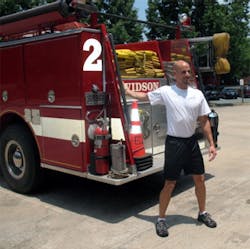Law enforcement has diverse physical demands that are inherent to the job. Long hours sitting while on patrol and then called into action with little notice. Standing and walking for long hours coupled with unpredictable physical apprehensions make law enforcement a truly challenging career physically and physiologically. Unlike Firefighters and EMS police officers are unable to exercise while on duty. There is however a way for an officer to integrate some fitness techniques into the course of a shift.
Sitting for long hours on patrol or walking the streets will cause your body to become tight and stiff, there is no way to avoid it. What can be done to combat the tightness and stiffness that occurs while on duty are some simple stretches to keep your muscles and joints primed and ready for action. Obviously performing complicated stretches on duty and in uniform is not only dangerous but just too difficult with all the gear an officer must carry on their person. There are however some common high injury potential areas that can be stretched while on duty, safely and easily. Focusing on muscles groups that are frequently injured such as the shoulders, knees and lower back will help to bolster a career with less potential injury and pain.
Surprisingly one of the easiest ways to stay loose on duty is to exercise. Human physiology dictates that to work out before your shift will yield far superior results. The primary reason is that late calls, paperwork and other on duty issues will not be a factor causing a missed workout. Pre-shift your body is not nearly as tight and stiff, fatigue is not as relevant and more than likely dehydration has not set in yet. Over the course of a shift, officers tend to consume less water, especially in busy systems and rural areas where restrooms are hard to find. Even minor levels of dehydration will hamper performance both on the street and in the gym. Staying hydrated seems simple, it is, and it will allow the on duty stretches to be more effective.
Stretching in uniform is designed to combat the negative effects of poor posture and repetitive positions inherent to law enforcement. Do not mistake on duty stretching with "normal" range of motion exercises necessary to perform your job, pass the POPAT and or protect form injury. On duty stretching will allow you to feel better and move better during and after your shift.
A lot of misinformation revolves around stretching, so lets clear that up right now. Longer is better and less is more. It takes time for a muscle to relax and stretch, research indicates up to 30 seconds for the muscle to just begin to relax and that is when most folks stop the stretch. Hold all the stretches for 60 seconds, longer is better! Stretching should be uncomfortable but never painful. Stretch into pain and the muscle naturally gets tighter to protect its self and that defeats the purpose of a stretch. Think moderately uncomfortable with stretching it will get you a lot further.
The on duty stretches demonstrated here are considered static which requires a longer duration hold. In subsequent articles we will explore functional stretching which has some definite carryover for tactical fitness. The take home message is that to be fit, flexible and feel good incorporate both static and functional stretching into your workouts.
Chest/Shoulder stretch: There are two versions of this stretch. The first version is for the chest and front of the shoulder. The second version is primarily for the back of the shoulder and lat. muscle. As these muscle groups become tight from poor postural positions they contribute to altered joint mechanics and will eventually lead to an injury.
Chest Stretch:
Preparation
- Place your hand against the door frame at shoulder height.
Movement
- Brace your abdominals, retract the cervical spine.
- (Neutral Spine Position)
- Slowly turn your body away from the door until you feel a stretch across the chest as well as the shoulder and bicep.
Tips
- To increase the stretch raise the sternum and or increase your rotation.
- Avoid twisting the spine.
Latissimus Stretch: (this is also a great stretch for the back)
Preparation
- Grasp a handle (sink, pole, railing, tree, car door with open window or door handle.)
Movement
- Slowly lean back and lower your butt, bending from the hips, until a stretch is felt.
Tips
- This is a great stretch for the lats, upper back, shoulders, lowerback and hamstrings. (hamstring stretch requires straighter legs)
Progression
- Moving feet closer and changing your torso angle will change the location of the stretch in the back.
- Perform with one arm.
Knee and Hip Stretch: Sitting, standing, walking/running and improper exercise will lead to knee pain and eventually injury. Tight muscles in the hip alter the normal movement patterns of the pelvis and this in turn effects how the knee functions. Injuries will happen, there is no way to prevent that but we can prevent the common biomechanical issues that cause many knee issues. Another great trick for on duty fitness is that keeping the hips loose will help keep the lower back feeling and moving better.
Hip Stretch: (this is also a great lower back stretch)Preparation:
- Place your leg on a table, counter, desk, or any other knee to waist high object.
Movement:
- Keeping your back flat and your head up, slowly lean forward until a stretch is felt in the hip and glutes.
Tips:
- Step in closer if you need less of a stretch, step farther back if you need a greater stretch.
- There should never be pain in the knee with this stretch, discontinue if pain is felt in the knee.
Hip Flexor Stretch:
Preparation:
- Place your foot on the edge of a table, counter top, desk or car hood.
- Stand tall with your balance leg slightly in front of you.
Movement:
- Without leaning or arching your back slowly bend the balance leg knee until a stretch is felt in front of the opposite leg.
Tips:
- Never arch your back.
- The deeper you bend your balance leg, the greater the stretch.
About the Author
Bryan Fass
is a leading expert on public safety injury prevention. As the president and founder of Fit Responder Bryan’s company works nationally with departments, corporations; state and local governments to design and run targeted injury prevention and wellness programs. He is frequently contacted for expert opinion and content contribution for all aspects of public safety fitness, ergonomics and wellness. Bryan authored the Fit Responder book used by departments and schools plus writes for numerous web and peer-reviewed journals including the NSCA-Tactical Strength & Conditioning journal, officer.com, ems-1.com & best practices in EMS. Bryan holds a bachelors’ degree in sports medicine with over 17 years of clinical practice, was a paramedic for over 8 years, and is certified as an Athletic Trainer (ATC, LAT), Strength Coach (CSCS) and the Functional Movement Screen (FMS). Fit Responder developed the nation’s first validated pre-hire Physical Abilities Test for EMS. Bryan is a sought-after speaker on a variety of topics including risk reduction, employee self-care, real world wellness and How to Eat on the street. www.fitresponder.com
Every Lift Counts!

